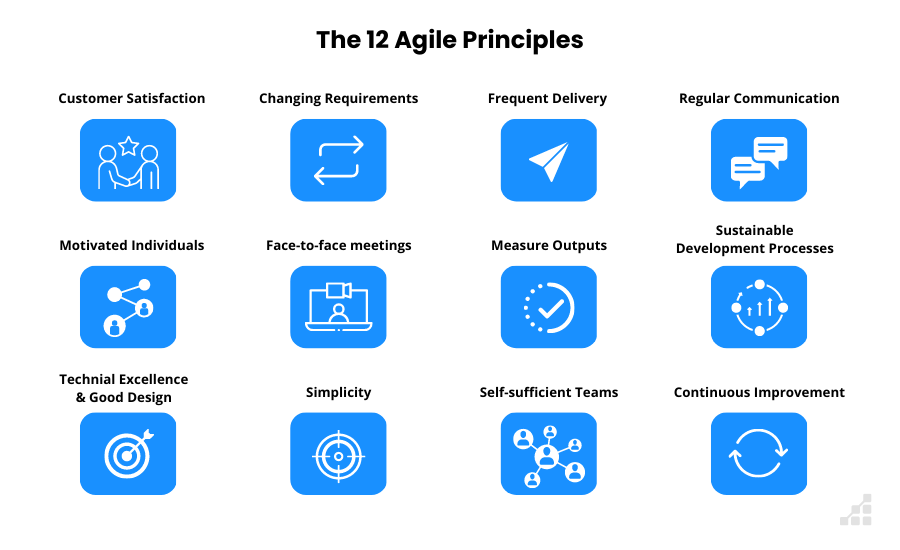
Have you ever wondered what the Agile Manifesto really is? A guide to effective, customer-focused software development, but also a philosophy emphasizing lean principles, flexibility, and customer satisfaction. Formed by 17 software developers in 2001, the Agile Manifesto advocates for a new approach to software development.
Key Points:
- Lean principles and customer satisfaction are at the core of Agile software development philosophy
- The Agile Manifesto comprises four fundamental values and twelve principles
- Unearth case studies that display the successful application of Agile methodologies
Statistics in 2024:
| Strategy | Previous adoption rate | Current adoption rate |
|---|---|---|
| Agile methodologies | Previously undisclosed | These rates will be updated as per future trends |
By understanding and integrating the Agile Manifesto’s values and principles into your organization, you can revitalize your software development process.
1. Introduction Agile Manifesto in Software Development
Introduced by an assembly of seventeen experts in 2001, the Agile Manifesto caused a seismic shift in software development practices. Traditionally convoluted processes were streamlined into four core values and twelve practical principles. This framework, while unyielding in its focus on product excellence and process improvement, allows for adaptability in application according to unique business contextual requirements.
The Agile Paradigm:
- A revolutionary shift in software development practices birthed in 2001.
- An adaptive compass that facilitates directions for business excellence, as opposed to a rigid roadmap.
- A flexible framework accommodating the unique contexts and requirements of every business.
- Fosters a focus on operational efficiencies, high-quality software delivery, and continuous improvements.
Agile methodologies have become extensively ingrained in organizational practices across the software industry. Embraced by both budding startups and established multinational enterprises, Agile software development is more than a trend – it’s a long-term, sustainable strategy characterized by customer-focused manoeuvrability and unyielding quality adherence.
2. The Four Core Values of the Agile Manifesto

Let’s quickly shed light on Agile software development before we explore its revolutionary manifesto. Agile is fundamentally a thought process, a unique approach of visualizing work, replacing the conventional waterfall project management method.
“Agile is not a methodology, but a mindset that appreciates constant change and expected uncertainty, transforming it into leverage, instead of invoking fear.“
Different Agile forms and methodologies, such as Scrum, Kanban, or Lean, uphold shared core values and principles, forming the Agile Manifesto. You could think of the Agile Manifesto as the Agile constitution, setting Agile apart from other project management and product development frameworks.
The Agile Manifesto highlights two aspects:
- Prefers individuals and their interactions over processes and tools
- Values working software, customer collaboration, and responding to changes over documentation, contract negotiation, and following plans, respectively
| Agile Value | Description |
|---|---|
| Individuals and Interactions over Processes and Tools: | Stresses on human interaction and team collaboration. |
| Working Software over Comprehensive Documentation: | The main objective is to deliver functional software. |
| Customer Collaboration over Contract Negotiation: | Favors direct client collaboration over negotiating terms. |
| Responding to Change over Following a Plan: | Adaptability to change takes priority over strictly adhering to a plan. |
Want to dive deeper into Agile’s core values? Check out our concise guide The Four Core Values of Agile. It offers detailed value explanations, insightful perspectives of Agile’s philosophies, and practical examples. Dig in and discover the recipe behind Agile’s success.
3. The Twelve Principles of Agile Software Development

Imagine the Agile Manifesto as a tree. The roots are firmly grounded in four core values, which give birth to twelve dynamic branches, or guiding principles:
- Customer satisfaction via early, ongoing delivery
- Embracing changing requirements
- Frequent delivery of operational software
- Developer-business collaboration
- Building around motivated groups
- Preferring face-to-face interaction
- Gauging progress with working software
- Upholding sustainable development pace
- Ensuring technical excellence and design
- Emphasizing simplicity
- Encouraging self-organization within teams
- Promoting regular reflection and tweaks
Over two decades, Agile has evolved beyond software development, revolutionizing various industries and boosting job demand in the field.
Explore our insightful delve into the 12 principles of Agile software development. Whether you’re a developer, manager, or CEO, these principles can revolutionize your productivity. Explore more in our article: Exploring the 12 Principles of Agile Software Development.
4. Challenges and Solutions: Applying the Agile Manifesto to Your Organization
Initially, implementing the Agile Manifesto may appear cumbersome due to some challenges. However, these can be overcome with appropriate strategies and a shift in mindset. Let’s break down these challenges and discuss possible solutions.

Overall Challenges and Solutions
| Challenge | Solution |
|---|---|
| Interpreting the Agile Manifesto Understanding the Agile principles and values within your unique organizational context. | Conducting trainings and workshops to enhance the team’s understanding and interpretation of Agile principles. |
| Integration with Existing Processes Aligning Agile principles with current project management methodologies, potentially encountering initial resistance. | Securing stakeholder buy-in, fostering open dialogues, holding educational workshops, and highlighting Agile benefits. With 32% confirming this (2024 Statistics), securing stakeholder buy-in is crucial. |
| Cultural Shift Transitioning to an Agile culture that promotes transparency, communication, and collaboration. | Initiating a gradual change, encouraging open communication, facilitating team collaboration, and adopting an iterative project approach. |
| Ensuring Quality Maintaining quality in an iterative Agile environment. | Incorporating quality checks at every Agile cycle step and adopting regular reflections on the work and process. |
To sum up, while the transition to Agile mandates challenges, they can be effectively managed with a thoughtful approach, adaptability, and consistent focus on change. With these solutions, Agile implementation can significantly improve the development process and lead to the creation of better products.
5. Case Studies: Successful Implementations of the Agile Manifesto

If you’ve been questioning the power of the Agile Manifesto, here are brief, yet potent, snapshots of three giants who have reaped enormous benefits from its implementation:
| Company | Transition | Benefits |
|---|---|---|
| IBM | Adopted Agile in 2003 to streamline complex, time-intensive processes. | Decreased development costs by 37% and enjoyed more frequent releases and heightened customer satisfaction. |
| Spotify | Implemented Agile by forming autonomous, cross-functional squads. | Reflects Agile principles in decision-making and adapting to market changes, aiding Spotify in dominating the music streaming industry. |
| Suncorp | Incorporated Agile to enhance its banking and finance services. | Leveraged Agile for improving communication, embracing changes, leading to higher quality solutions and stronger customer trust. |
These brief success stories illustrate the versatility and efficacy of the Agile Manifesto across diverse industries, from tech to traditional sectors. And while exact 2024 statistics remain anticipated, it’s clear that Agile software development continues to gain momentum globally.
Now, it’s your turn. Inspired by the transformations above, envisage Agile’s potential for your organization. Ready to join the Agile software development revolution?
6. Recap of the Agile Manifesto Discourse
Over the course of this article, we’ve extensively dissected the Agile Manifesto. From its deeply rooted values to its influential principles, there is no denying its profound impact on the world of software development.
Remember that one of main pillars of this Manifesto is a focus on individuals and interactions, superseding processes and tools. Yes, the best results often come from humans collaborating seamlessly, driving projects forward with motivation and passion.
7. Commonly Asked Inquiries
Q1. What is the Agile Manifesto?
The Agile Manifesto is a document that sets out the essential values and principles for Agile software development. It was created by leading figures in the software industry and has had a profound impact on the way software is developed today.
Q2. Who were the 17 software developers in 2001 that created the Agile Manifesto?
The seventeen software developers who authored the Agile Manifesto in 2001 are: Kent Beck, Mike Beedle, Arie van Bennekum, Alistair Cockburn, Ward Cunningham, Martin Fowler, James Grenning, Jim Highsmith, Andrew Hunt, Ron Jeffries, Jon Kern, Brian Marick, Robert C. Martin, Steve Mellor, Ken Schwaber, Jeff Sutherland, and Dave Thomas.
Q3. What are the four core values of the Agile Manifesto?
The four core values are: individuals and interactions over processes and tools; working software over comprehensive documentation; customer collaboration over contract negotiation; and responding to change over following a plan.
Q4. What are the twelve principles of Agile software development?
https://kvytechnology.com/videos/boosting-productivity-with-generative-ai/The twelve principles include customer satisfaction through early and continuous delivery, welcoming changing requirements, frequent delivery of working software, collaboration between business people and developers, and the promotion of motivated individuals, among others. Each principle provides a guideline for fostering an Agile software development environment.
Q5. How does the Agile Manifesto improve software development?
The Agile Manifesto encourages a flexible, collaborative approach to software development. It values working software and customer collaboration above strict adherence to processes and documentation. This leads to higher quality software, satisfied customers, and motivated teams.
Q6. What challenges might an organization face when implementing Agile?
Challenges can include changing established processes, dealing with resistance to change, ensuring clear communication, and maintaining a sustainable pace of development. However, these can be overcome by following the Agile values and principles and adapting them to the unique needs of each organization.
Research materials:
- Agile Manifesto Principles
- ACM SIGSOFT Software Engineering Notes
- Fitzgerald, B. “Agile and Iterative Development A Manager’s Guide”
- A guide to the project management body of knowledge (PMBOK guide)
- Project Management Institute (PMBOK Guide)
- Information Radiator
Relevant Internal Links:


